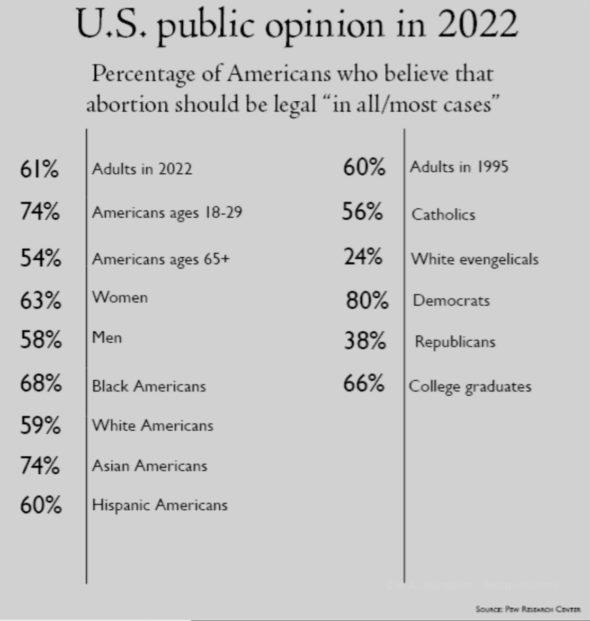As laws change, citizens must consider the complexity of other perspectives
Take a minute and consider the lens through which you see the world. How were you raised? With money? With two parents? With access to sex education? With a uterus? Given even just a small change in luck, location, privilege, or circumstance, your story could be different-your story could be that of Anna.
Anna’s story
Anna-or so I will call her because she has requested anonymity for safety reasons-just turned 16. Anna lives in Texas, where abortion is currently illegal, and was partly illegal even before Roe v. Wade was overturned last June. Due to a combination of legal restrictions and stigma, in Anna’s case, abortion was simply not an option.
 “When I first found out I was pregnant I realized my parents were not going to be very supportive…when [I eventually told them about the pregnancy]…they said ‘we don’t care what you do,'” explained Anna. “I was on my own,” she continued. “They wanted no part in it…so I…figured it out.”
“When I first found out I was pregnant I realized my parents were not going to be very supportive…when [I eventually told them about the pregnancy]…they said ‘we don’t care what you do,'” explained Anna. “I was on my own,” she continued. “They wanted no part in it…so I…figured it out.”
For Anna, cutting ties with her family was difficult but necessary. But the obstacle that followed was almost more daunting: she had to find the resources she needed to safely give birth.
“I still went to school during my pregnancy, and I did research on the authority I’d have being a mom at a young age. When you have a baby as a teen you can legally get your own medical [coverage]. I got an OB-GYN, but it took me maybe four full days of phone calls from 9-4 to find one to take my Medicaid.”
As frustrating as Anna’s experience was, it is not an anomaly. Three in 10 teens will become pregnant; one in four of those young mothers will go on a welfare benefit program. Whether it’s due to absence of parents, lack of schooling or abandonment by a partner, poverty and teenage pregnancy tend to be fundamentally intertwined.
The fact that Anna was able to endure 28 hours on the phone to find an OB-GYN is a rarity. Only 69% of pregnant adolescents aged 15-19 years old even receive care beginning in the first trimester of pregnancy, and only 64% receive what is considered early and adequate prenatal care.
Despite her hopes and efforts, Anna’s pregnancy did not go as planned.
“I had an emergency C-section and had her at 20 weeks and four days,” said Anna.
She was hospitalized for two and a half weeks.
“Not a fun experience. I passed out when they did the epidural, and I remember when they were taking her out I felt the tugs and pulls,” said Anna, grimacing.
Her daughter was born three months premature and instead of going home after birth, she went straight into the Neonatal Intensive Care Unit (NICU).
“Having a kid in the NICU at sixteen …,it’s really scary, but she’s fighting.”
Adolescent mothers, defined as mothers who are 10-19 years old, face higher risks of eclampsia, puerperal endometritis and systemic infections than women aged 20-24 years, and babies of adolescent mothers face higher risks of low birth weight, preterm birth and severe neonatal conditions.
When interviewing Anna, I kept forgetting that she was a teenager-in fact, someone almost exactly my age. But on reflection it is breathtaking that she managed to navigate high school and growing up while also carrying a child for months, giving birth, and ultimately learning to fend for herself in order to care for herself and her child.
“I was in a dance company so I had to give that up,” she explained, “It was hard because I had to grow up really fast, It’s a lot to face and it’s very scary.” She then quietly acknowledged, “Usually people like me…things don’t turn out as well.”
Abortion and U.S. law
On January 22, 1973, the Roe v. Wade ruling made access to abortion a federal right in the United States. On June 24, 2022, Roe v. Wade was overturned (in Dobbs v. Jackson Women’s Health Organization), leaving it up to individual states to allow, curtail, or ban abortion rights: Anna’s situation is now a striking new reality for teens across the country.
In light of the overturning of Roe v. Wade, today, a pregnant teenager like Anna who lives in Texas-regardless of her abilities, support system, education, and life situation-would not be empowered to decide to take the morning-after pill or to have an abortion because she was not in a position to raise a child.
Today, in Texas, and in Alabama, Arkansas, Idaho, Kentucky, Louisiana, Mississippi, Missouri, Oklahoma, South Dakota, and Tennessee, any and all 16-year-old Anna’s are now required to also give birth.
As James Mohr describes in his book, Abortion in America, abortion was a relatively accepted and a fairly common practice, not always illegal or controversial. A sudden shift transpired in the 1850s when the newly established American Medical Association called for the criminalization of abortion. This call was, in part, an attempt to eliminate doctors’ competitors, like midwives and homeopaths.
Then, in 1869, the Catholic Church openly banned abortion at any stage of pregnancy, leading to a spiral of anti-abortion laws and protests. By the 1880s, abortion was outlawed across the country.
Nearly a century later, Norma McCorvey, a Texas woman in her early 20s, sought to terminate an unwanted pregnancy. At the time of her pregnancy, abortion was legal in Texas, but only to save a woman’s life.
When denied an abortion, McCorvey hit rock bottom and, as a last resort, sought out an illegal back-alley abortion. After this unsuccessful attempt, McCorvey was referred to Texas attorneys Linda Coffee and Sarah Weddington, who were interested in challenging anti-abortion laws. In court documents, McCorvey assumed the identity “Jane Roe.”
Dobbs v. Jackson
In 2018, Mississippi attempted to ban abortions after 15 weeks of pregnancy. In response, the last remaining abortion clinic in Mississippi challenged the state’s ban: the case was promptly taken to the Supreme Court.
Initially, Mississippi asked for the Court to uphold its ban, attempting to argue that it was consistent with Roe v. Wade. Their strategy quickly changed, however, when Justice Amy Coney Barrett was confirmed to the Supreme Court. Mississippi asked the Court to overrule Roe v. Wade outright.
Hetal Dalal, a professor at Mitchell Hamline School of Law in St. Paul, is chair of the board of a local organization, Gender Justice.
“Gender Justice has been working to expand access to abortion in Minnesota since we understood the makeup of the Supreme Court was going to change,” explained Dalal. “We filed a lawsuit, Doe v Minnesota, which led to the removal of many, many restrictions in the state.”
On July 11, 2022, the District Court permanently blocked a series of laws in Minnesota deemed outdated, including one which required that young people notify both parents before they can receive abortion care.
“The impact of Dobbs nationally has been huge,” Dalal notes. “I think 20 states at this point have severely restricted or given no access at all to abortion…considering abortion is medical procedure, that means, likely, many people are going without needed medical care.”
According to the CDC, In 2020, 51% of all abortions were early medical abortions.
“Minnesota has been impacted in seeing people from states where abortion is now unavailable come and get there medical procedures here,” Dalal explains.
So what does this mean for the future, what’s next for abortion access, laws, and politics? “There are two bills that have been proposed to congress but it’s not likely either of those will pass,” Dalal said.
Siding with Anna
Abortion is complicated, it’s messy, and it’s emotional. Imagining getting an abortion yourself or supporting someone you love as they get an abortion might make you sad. Honestly, it makes me sad too. But what makes me even more devastated is the thought that friends, mentors, strangers could decide to take an unwinnable, complex, emotional decision, and mandate that their beliefs against abortion are the answer for everyone.
On the simple side of the debate, it seems impossible for anyone to refuse to acknowledge the necessity of access to abortion in cases where the fetus won’t survive on its own or will suffer life-threatening complications; the cases where the mom might die; the cases of rape or incest.
You might dismiss these scenarios-rape in particular-as an anomaly. But they are not. For example, 1 out of every 6 American women has been a victim of an attempted or completed rape in her lifetime, according to the Rape, Abuse & Incest National Network (RAINN). One out of every 6.
I acknowledge that there are also harder parts of this debate. But at the end of the day, regardless of the scenario, I pick Anna. I pick Anna because I trust her as a fellow human – emotional, messy, imperfect, and complex -to make the best choice for herself and her fetus. And, I hope you, too, pick Anna so that we can continue to look at each other and hope together we never have to know what it’s like be in a position to choose in a world where choices abound.

